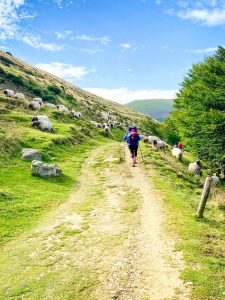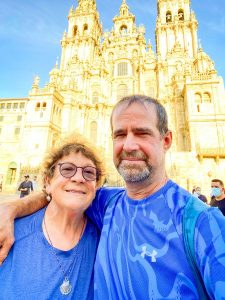Modern-day pilgrims –
Complete the Camino de Santiago trail
By Lisa Nicklanovich; photos courtesy of Felicity Thompson

Averaging 12 miles of walking the ancient trail each day, the couple persevered through the steep and rocky terrain of the Pyrenees and damp coastal sections, walking by flocks of sheep and feral horses
“I liked digging deep and finding that piece of me that could do something hard which I kind of knew but hadn’t proved it in a while,” said Forest Park resident Felicity Thompson of walking the Camino de Santiago (Camino), a 500-mile pilgrimage of medieval origin, with her husband, Richard.
After extensive planning and training, the couple began in the town of St. Jean Pied de Port, in southern France and followed the route to the Cathedral of Santiago de Compostela in Galicia, in the northwest of Spain. Scallop shells, the symbol of the pilgrim, and yellow arrows provided signposts along the way.
Averaging 12 miles of walking the ancient trail each day, the couple persevered through the steep and rocky terrain of the Pyrenees and damp coastal sections, walking by flocks of sheep and feral horses. They traversed through vineyards, medieval towns, busy cities and rail yards.
“There’s a slowing down and meditative peace of walking through a place,” said Felicity. “It felt intimate to essentially walk through people’s backyards, to see people working in their beautiful home gardens, to observe people hanging their laundry. You don’t see it driving and you certainly wouldn’t chat with an old gardener about how beautiful his tomatoes looked.”
Felicity admitted she was concerned whether or not she had the physical capacity to walk 500 miles, especially considering she needed a hip replacement. Richard needed a knee replacement, and they are both in their mid-60s. Felicity and Richard allowed themselves 60 days, however, they arrived in Santiago in 43 days. They got stronger along the way, encouraging each other and doing “little kindnesses for each other, despite all that togetherness,” Felicity shared.
A unique feature of the Camino is the system of pilgrim hostels, known in Spanish as “albergues,” along the route where pilgrims can spend the night in dorm-like sleeping arrangements. Sharing bathrooms and waiting for showers “got old fast” Felicity laughed.
Felicity confessed that wearing the exact same thing every day and feeling okay about it was a big revelation. “The things you learn about carrying everything on your back!” Felicity exclaimed.
The couple met many interesting people along the route who were walking the Camino for different reasons, some religious and spiritual, some for its culture, heritage or the physical challenge. Felicity said she had been fascinated with the idea for a long time and felt the Camino is uniquely special.

Felicity and Richard Thompson in front of the Cathedral of Santiago in Spain at the end of their 500-mile pilgrimage on the Camino de Santiago. It is every pilgrim’s goal to reach Santiago.
Upon reaching the final destination, the Cathedral of Santiago de Compostela, the couple attended a mass and earned their Compostela pilgrim certificate proving they walked the full 500 miles. The couple is proud to also have earned pilgrim passports full of unique stamps from all the places they traveled through. “It was nice to be a pilgrim and part of that inclusive community,” Felicity said.
For more information about the Camino, watch the movie The Way featuring Martin Sheen and his son Emilio Estevez. Felicity also recommends visiting www.americanpilgrims.org and navigating to the local Front Range chapter. Felicity and Richard attended meetings for two years before walking the Camino, gathering information and gaining enthusiasm. They continue to attend meetings to help aspiring pilgrims.